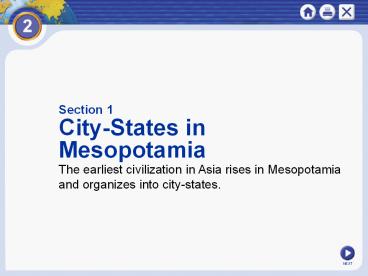NEXT - PowerPoint PPT Presentation
1 / 10
Title:
NEXT
Description:
Section 1 City-States in Mesopotamia The earliest civilization in Asia rises in Mesopotamia and organizes into city-states. NEXT NEXT Geography of the Fertile ... – PowerPoint PPT presentation
Number of Views:96
Avg rating:3.0/5.0
Title: NEXT
1
The earliest civilization in Asia rises in
Mesopotamia and organizes into city-states.
NEXT
2
City-States in Mesopotamia
Geography of the Fertile Crescent
The Fertile Crescent Fertile Crescentarc of
land between Persian Gulf and
Mediterranean Includes Mesopotamialand
between the rivers a fertile plain Tigris
and Euphrates rivers flood once a year, leaving
rich soil.
Map
Continued . . .
NEXT
3
continued Geography of the Fertile Crescent
Environmental Challenges Around 3300 B.C.
Sumerians begin farming southern
Mesopotamia Environment poses three
disadvantages - floods are unpredictable
sometimes no rain - land offers no barriers to
invasion - land has few natural resources
building materials scarce
Continued . . .
NEXT
4
continued Geography of the Fertile Crescent
Solving Problems Through Organization Sumerians
worked together find solutions to environmental
challenges - build irrigation ditches to
control water, produce crops - build walled
cities for defense - trade grain, cloth, and
tools for raw materialsstone, wood
metal Organization, leadership, and laws
are beginning of civilization
NEXT
5
Sumerians Create City-States
Sumerian City-States By 3000 B.C. Sumerians
build cities surrounded by fields of
crops Each is a city-statean independent
political unit Sumer city-states Uruk, Kish,
Lagash, Umma, and Ur Each city has temple and
ziggurat priests appeal to gods
Image
Continued . . .
NEXT
6
continued Sumerians Create City-Sates
Priests and Rulers Share Control Sumers early
governments controlled by temple priests Some
military leaders become rulers dynasties rule
after 2500 B.C. Dynastyseries of rulers from a
single family
The Spread of Cities By 2500 B.C. many new
cities in Fertile Crescent Sumerians exchange
products and ideas with other cultures Cultural
diffusionprocess of one culture spreading to
others
NEXT
7
Sumerian Culture
A Religion of Many Gods Sumerians believe in
many different gods polytheism Gods are
thought to control forces of nature Gods behave
as humans do, but people are gods
servants Life after death is bleak and gloomy
Life in Sumerian Society Sumerians have social
classeskings, landholders, priests at
top Wealthy merchants next at lowest levels
are slaves Women have many rights become
priests, merchants, artisans
Image
Continued . . .
NEXT
8
continued Sumerian Culture
Sumerian Science and Technology Sumerians
invent wheel, sail, and plow first to use
bronze Make advances in arithmetic and
geometry Develop arches, columns, ramps and
pyramids for building Have complex system of
writingcuneiform Study astronomy, chemistry,
medicine
NEXT
9
The First Empire Builders
Time of War From 3000 to 2000 B.C. city-states
at constant war
Sargon of Akkad Around 2350 B.C., Sargon from
Akkad defeats city-states of Sumer Creates
first empireindependent states under control of
one leader His dynasty lasts about 200 years
Image
Babylonian Empire Amorites, nomadic warriors,
take control of region around 2000 B.C. Make
Babylon, on Euphrates River, the
capital Babylonian Empire at peak during
Hammurabis rule (1792-1750 B.C.)
Map
Continued . . .
NEXT
10
continued The First Empire Builders
Hammurabis Code Hammurabi creates a code of
laws for the Babylonian Empire 282 laws on all
aspects of life engraved in stone and made
public Set different punishments depending on
social class, gender Goal for government to
take responsibility for order, justice Amorite
rule for Fertile Crescent ends 200 years after
Hammurabi
Image
NEXT































